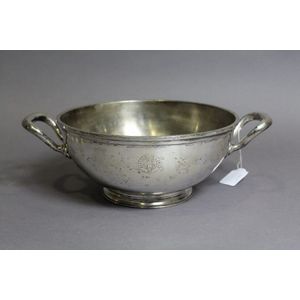Circular Sheffield Plate Chafing Dish with Shell Feet
You must be a subscriber, and be logged in to view price and dealer details.
Subscribe Now to view actual auction price for this item
When you subscribe, you have the option of setting the currency in which to display prices to $Au, $US, $NZ or Stg.
- Sheffield Plate - Sheffield plate was the first commercially viable method of plating metal with silver. The method of plating was invented by Thomas Boulsover, a Sheffield Cutler, in 1743 and involved sandwiching an ingot of copper between two plates of silver, tightly binding it with wire, heating it in a furnace and then milling it out in to sheet, from which objects could be made.
Originally used by its inventor to make buttons, the potential of the material was quickly realised, and soon it was being used to fashion boxes, salvers and jugs, and not long after that candlesticks and coffee pots, and other traditional tableware.
Although there was a considerable saving in the amount of silver used, Old Sheffield Plate manufacture was more labour intensive than solid silver, meaning higher labour costs. This meant that Old Sheffield Plate was very much a luxury product, and only available to the very wealthy.
The thickness of the silver means that many 18th century Sheffield Plate pieces still have a good layer of silver, while electroplated pieces (EPNS), may have been replated several times over their lifetime. Where the silver has worn off the Sheffield plate the soft glow of the copper base can be seen underneath. However this is not an infallible guide that the piece is Sheffield Plate, as many EPNS items were also plated on to a copper base.
Most Sheffield plate items are unmarked, whereas most elecroplated items display manufacturers names or marks, quality indications such as "A1", "EP", together with pattern or model numbers.
Sheffield plate was made commercially between 1750 and 1850. - Chafing Dish - A chafing dish is a type of portable heated tray or stand that is used to keep food warm during a meal or event. It is typically made of metal or stainless steel and has a shallow tray or pan for holding the food.
The tray is usually placed on top of a fuel burner, which generates heat to keep the food warm. Some chafing dishes also have a cover or lid to help retain heat and prevent contamination. Chafing dishes are often used at buffets, banquets, and other events where food is served and may need to be kept warm for an extended period of time.
This item has been included into following indexes:
Visually similar items

Christofle twin handle bowl, in silver plate marked Christofle, 62, 2942164 Approx 24 cm diameter

A small celadon bowl, 15 cm diameter. The Estate of Stanley Crawford Stevens.

Heavy George V sterling silver pedestal bowl, hallmarked, London, 1910, H.L and retail marks Lambert Coventry Street, London, of circular form, with ribbed surround and circular ribbed foot, total weight 217gm

Fine Chinese blue and white bowl and stand, Kangxi mark but 19th century, painted with a figure on a log floating on a sea, centre painted with various islands with double ring, bowl approx 8 cm high, 12.5 cm diameter
